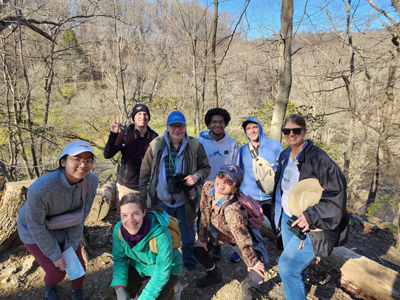 Southeast from my base of operations in Abingdon, two walks in Grayson Highlands State Park.
Southeast from my base of operations in Abingdon, two walks in Grayson Highlands State Park.

 From the visitor center, the Twin Pinnacles Trail is maybe only 55 meters of elevation change, but there’s a fair amount of up and down. The scramble down from Big Pinnacle was a bit tricky.
From the visitor center, the Twin Pinnacles Trail is maybe only 55 meters of elevation change, but there’s a fair amount of up and down. The scramble down from Big Pinnacle was a bit tricky.

 I liked the shelter/rest stations along the way, at least two of them marked as scout projects. Thank you, scouts!
I liked the shelter/rest stations along the way, at least two of them marked as scout projects. Thank you, scouts!
 Spruces at the skyline show some flagging.
Spruces at the skyline show some flagging.

The walk was a little easier going down, 2:20 for the loop.
I found patches of Appalachian White Snakeroot (Ageratina roanensis or A. altissima var. roanensis, depending on your authority), a mystery goldenrod at the Little Pinnacle summit, a mystery whorled composite, and a mystery bryophyte.
 A younger me would have tried the walk from Big Pinnacle to Massie Gap, but the prudent present me drove back to Massie Gap for an afternoon loop that used about 3/4 mile of the Appalachian Trail along Wilburn RIdge. I walked the Maine-bound direction; I wasn’t overtaken by any spry through-hikers, but there were some folks to say hello to going the other direction. The AT here is fairly level, a rhododendron thicket with random unmarked side trails and more spruce.
A younger me would have tried the walk from Big Pinnacle to Massie Gap, but the prudent present me drove back to Massie Gap for an afternoon loop that used about 3/4 mile of the Appalachian Trail along Wilburn RIdge. I walked the Maine-bound direction; I wasn’t overtaken by any spry through-hikers, but there were some folks to say hello to going the other direction. The AT here is fairly level, a rhododendron thicket with random unmarked side trails and more spruce.
Some fairly large vaccinium shrubs. About 85 meters of elevation change, 2:20 for the loop.






































